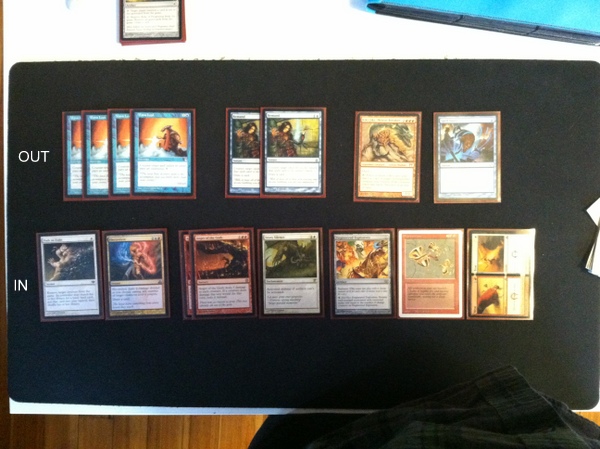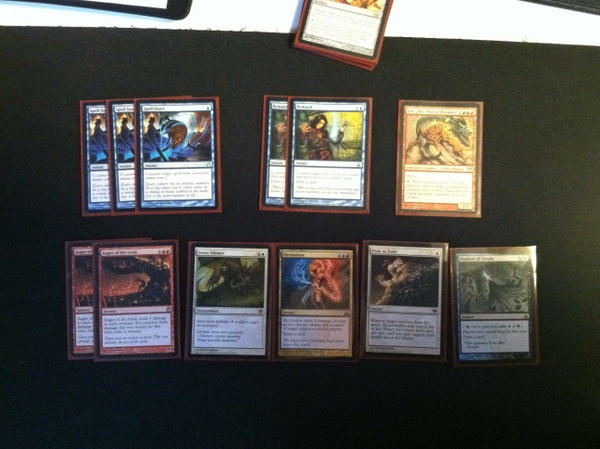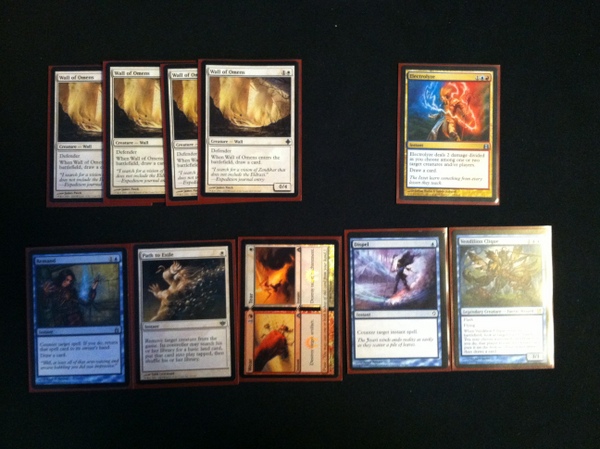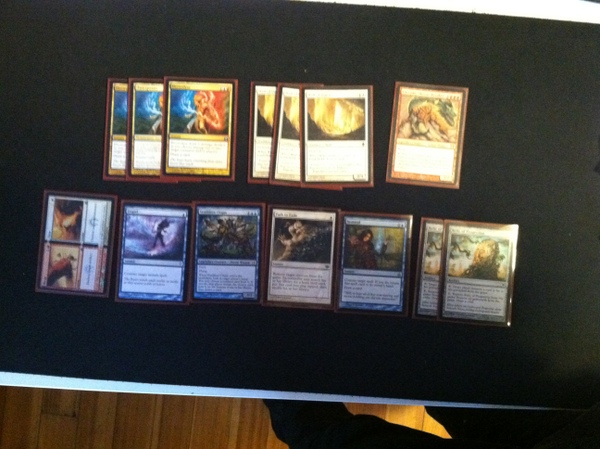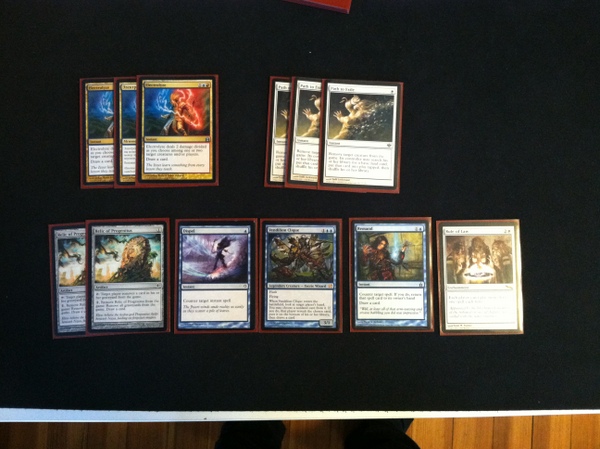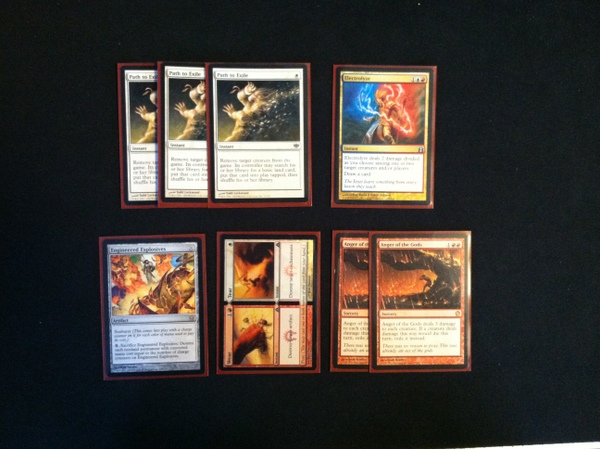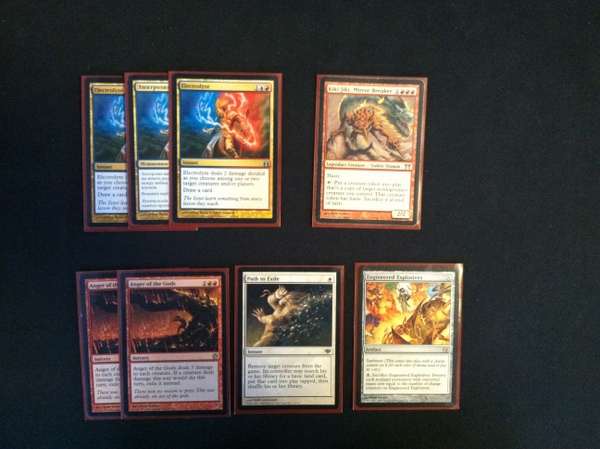After playing UWR Twin for a bit in Modern, I realized something: Tempo Twin and Tarmo-Twin were better combo decks and American Control was a better control deck. This is not to say that UWR Twin was strictly worse than these decks, the [casthaven]Celestial Colonnade[/casthaven]/[casthaven]Splinter Twin[/casthaven] deck had a very potent game against aggro and great sideboard options thanks to the white splash. The problem for me was that [casthaven]Deceiver Exarch[/casthaven] and [casthaven]Splinter Twin[/casthaven] are really good when you win the game with them but pretty lousy in the grindy match-ups. I found myself awkwardly beating down with a flashy[casthaven] Horned Turtle[/casthaven] or with a handful of [casthaven]Splinter Twin[/casthaven]s while looking at a board of [casthaven]Restoration Angel[/casthaven]s and [casthaven]Celestial Colonnade[/casthaven]s. I wanted the deck to be a better control deck that could win games with a combo kill, not a deck that mashed some combo pieces and some control ones and hoped for the best. Fortunately, I was not the only person to feel this way, and a Kiki-Control decklist magically materialized on my computer monitor after a friend shipped me the list. Paul Nemeth—Zwischenzug on MTGO— is perhaps best known for playing the deck, so I started with his list and played a bunch of games with it:
UWR Kiki
| Lands (26) 4 Celestial Colonnade 1 Hallowed Fountain 1 Cascade Bluffs 4 Scalding Tarn 3 Steam Vents 4 Arid Mesa 1 Sacred Foundry 1 Plains 2 Island 2 Mountain 1 Desolate Lighthouse 2 Tectonic Edge Creatures (15) (15) 4 Wall of Omens 4 Snapcaster Mage 4 Restoration Angel 3 Kiki-Jiki, Mirror Breaker Instants (19) 4 Lightning Bolt 3 Path to Exile 3 Spell Snare 4 Mana Leak 2 Remand 3 Electrolyze | Sideboard (15) 1 Path to Exile 1 Dispel 2 Relic of Progenitus 1 Remand 1 Shadow of Doubt 1 Stony Silence 1 Anger of the Gods 1 Electrolyze 2 Rule of Law 1 Vendilion Clique 1 Shatterstorm 1 Engineered Explosives 1 Wear // Tear |
The question with any innovative take on a pre-existing archetype is,” how is this deck better than the previous incarnation?” In this case, you’re giving up [casthaven]Cryptic Command[/casthaven]s, [casthaven]Ajani Vengeant[/casthaven], and [casthaven]Sphinx’s Revelation[/casthaven] for Kiki Jiki and…[casthaven]Wall of Omens[/casthaven]. Here we’re clearly sacrificing power for synergy and the ability to win out of nowhere with Kiki and [casthaven]Restoration Angel[/casthaven]. The beauty of the combo is that opponents’ often don’t see it coming and that it allows you to win games where a regular control list would be too far behind to pull ahead; unwinnable board states quickly become a playground for your million [casthaven]Restoration Angel[/casthaven]s.
Aside from the combo, this is deck based around [casthaven]Wall of Omens[/casthaven]. Wall comes down early, draws you a card, holds off most attackers in the format, then gets blinked by [casthaven]Restoration Angel[/casthaven] for value, and copied by Kiki for even more value. This deck is a [casthaven]Wall of Omens[/casthaven] deck and is a good metagame choice when the format has a lot of Zoo/Burn/Aggressive decks. This deck is not a good metagame choice when your meta is full of combo decks, since an 0/4, even one that cycles, doesn’t do a whole lot against a huge [casthaven]Lightning Storm[/casthaven] or massive [casthaven]Grapeshot[/casthaven]. However, even in match-ups where wall doesn’t do too much, the ability to smooth out draws at least makes it a live draw. In match-ups where it’s bad, ie against unfair non-creature decks, [casthaven]Wall of Omens[/casthaven] becomes a good target for your own [casthaven]Path to Exile[/casthaven]s. While it seems a little goofy, being able to cast an instant speed [casthaven]Rampant Growth[/casthaven] to ensure land drops is actually pretty good.
Now that I’ve discussed the crux of the deck, [casthaven]Wall of Omens[/casthaven], let’s break down the other card choices:
Creatures—All the creatures in the deck are built around having ETB abilities abuseable with Kiki-Jiki and [casthaven]Restoration Angel[/casthaven]. Snapcaster is obviously insane but only gets better when you can blink him with [casthaven]Restoration Angel[/casthaven] or copy him with Kiki-Jiki. The biggest tension with the creature base is that you play three Kiki-Jikis. You really want to draw one but obviously doubles of the legendary creature can be awkward, especially in your opening hand. I often find myself siding out a Kiki or two in situations where a vulnerable five-mana creature is not what you want.[casthaven] Restoration Angel[/casthaven] obviously wins the game when paired with Kiki, protects your other creatures, and gets value off their ETB abilities, but perhaps most importantly, it is a 3/4 flying creature that can end the game on its own. Most games come down to clearing out the skies with burn and removal and swinging in with Resto.
Counters—Since Kiki Control is primarily a reactive control deck, we’re looking to hold up counter Magic whenever possible. [casthaven]Mana Leak[/casthaven] is the best two mana counter in the format, [casthaven]Spell Snare[/casthaven] is perhaps the most cost efficient, and [casthaven]Remand[/casthaven] buys us time and draws cards. The counter suite is pretty standard except for the notable exception of [casthaven]Cryptic Command[/casthaven]. Cryptic is amazing in the American Control lists but there just isn’t room for it here especially when Kiki-Jiki is so red mana intensive.
Removal— [casthaven]Path to Exile[/casthaven] and [casthaven]Lightning Bolt[/casthaven] are the most efficient removal options in the format and obviously amazing with [casthaven]Snapcaster Mage[/casthaven]. However, I’m not sure I’m entirely sold on [casthaven]Electrolyze[/casthaven]. While [casthaven]Electrolyze[/casthaven] is impressive against Pod’s mana dorks and Affinity’s robots, I think it’s probably the most replaceable card in the deck. It’s nice drawing the card but a little extra burn in the form of [casthaven]Lightning Helix[/casthaven] or reach in the form of [casthaven]Izzet Charm[/casthaven] could potentially replace the three mana spell.
Sideboard—Rather than list out the potential uses of each card in the sideboard, I’ve included a visual sideboarding guide below. Please note that in the sideboard of my deck I have two [casthaven]Anger of the Gods[/casthaven] rather than two [casthaven]Rule of Law[/casthaven]. Also, these pictures are meant to provide a basic idea of what to sideboard, not a definitive guide.
Affinity—
You just don’t have time to mess around with counterspells so you just bring in board wipes and spot removal. It is worth noting that you can keep in [casthaven]Spell Snare[/casthaven] since it’s cheap and counters Ravager, Overseer, and [casthaven]Cranial Plating[/casthaven].
Melira Pod—
Normally you would bring in [casthaven]Relic of Progenitus[/casthaven] here, but its a really big nonbo with [casthaven]Stony Silence[/casthaven], so I think it’s fine to leave them out. I like leaving in the [casthaven]Mana Leak[/casthaven]s since it keeps them honest with casting their [casthaven]Birthing Pod[/casthaven]s but all the other counter magic is bad.
UR Twin—
[casthaven]Wall of Omens[/casthaven] comes out here since it doesn’t interact with the combo and basically just can’t be played if you’re on the draw. Here we bring in stuff to disrupt the combo or win a counter war.
Tarmo Twin—
Given the fact that they play [casthaven]Tarmogoyf[/casthaven], Snapcaster, and [casthaven]Scavenging Ooze[/casthaven], you have to bring in some kind of graveyard hate. Bringing in Relic is a little awkward since it doesn’t interact with the Twin combo, but a mage has got to do what a mage has got to do.
Storm—
Here you board out all of your dead removal for ways to interact with them. [casthaven]Rule of Law[/casthaven] is very good but unfortunately I cut one from Nemeth’s list since I really wanted the second [casthaven]Anger of the Gods[/casthaven]. If you’re playing against Ad-Naseaum, you can leave the Relics in the board and side in [casthaven]Wear/Tear [/casthaven]and [casthaven]Stony Silence[/casthaven].
Boggles—
The best advice is to just not play against Boggles or to draw the one of [casthaven]Engineered Explosives[/casthaven], otherwise this match-up is not very good.
Zoo—
[casthaven]Electrolyze[/casthaven] doesn’t kill enough of their creatures and you can’t stumble and draw multiples of Kiki here. Anger, Path, and Explosives are all reasonable ways to control their creature population.
At age 15, while standing in a record store with his high school bandmates, Shawn Massak made the uncool decision to spend the last of his money on a 7th edition starter deck (the one with foil [casthaven]Thorn Elemental[/casthaven]). Since that fateful day 11 years ago, Shawn has decorated rooms of his apartment with MTG posters, cosplayed as [casthaven]Jace, the Mindsculptor[/casthaven], and competes with LSV for the record of most islands played (lifetime). When he’s not playing Magic, Shawn works as a job coach for people with disabilities, plays guitar in an indie-pop band, and keeps a blog about pro-wrestling.


